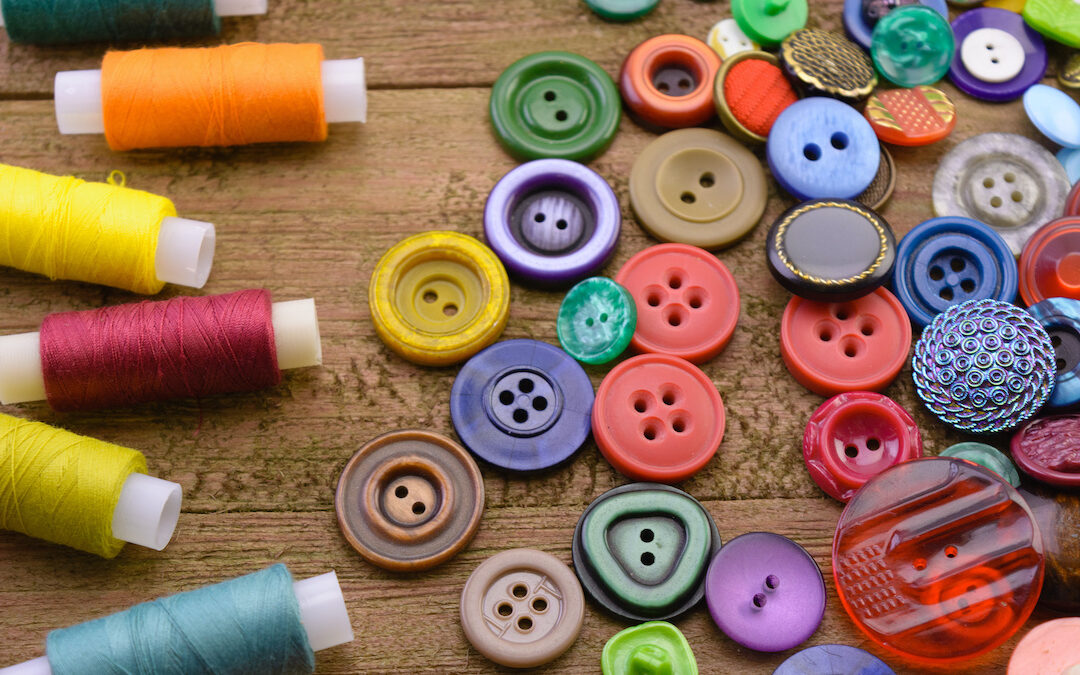Products are often designed to fail so we’ll buy more stuff. How a knock-down, drag-out battle over a button inspired me to dig a little deeper.
A button started the whole problem.
One day, the button just disappeared.
Not one of the pretty buttons in the picture but a little, spring-loaded silver one that allows me to easily vacuum. When pressed in, the button releases the handle so it can be used with the long wand to get those edges and crevices along the floor, or on its own to suck out crumbs and whatnot in those dark, scary places deep within the couch.
The handle then slides back onto the machine over the button, clicking into its proper position to hold all the parts together and steer the vacuum cleaner.
Then the button disappeared.
Nothing but my grip kept all the parts from shimmying around, as I held the machine awkwardly around the neck.
Kind of like vacuuming with a giant, wobbly rubber chicken.
While vacuuming is never my favorite thing, I like the result. Fighting with the vacuum cleaner is just plain frustrating.
The Good Fight
I was steamed. Plenty of people would have given up right here, tossed out the vacuum and bought a new one. But I’m not most people.
You see, this Hoover vacuum cleaner is maybe three years old. It was neither top-of-the-line, nor a cheapie. It should last more than a few years. It is, after all, a well-established brand.
Have you been there, too? Feeling forced to spend money to replace something that just should have lasted longer. Or something you would happily repair, if you could only find the parts.
Bet you have. Maybe you’ve even muttered to yourself “They just don’t make things like they used to” — which is true, not your imagination at all.
I do my best to avoid the throw-away society that hits our pocket-books and has damaged the natural world with an insatiable hunger for resources. We buy the best quality products we can afford, typically after researching reviews and testing in Consumer Reports.
We maintain, take care of and repair stuff. I am driven to recycle what cannot be fixed, re-purposed or sent to the thrift store. Yes, I can go a little overboard.
I strive for peace in my connection to the natural world, to fight the good fight and squeeze the last life out of an object before sending it to a landfill. Wear it out. Use it up. Make do or do without!
Drowning in a Sea of Plastic
One big reason: Plastic pollution.
Plastics break down into tiny pieces known as microplastics that kill wildlife and have worked their way into the food chain. Yes, plastics give us lots of benefits: food safety and medical equipment. I am writing on plastic keys and see the screen through plastic eyeglasses.
But the price.
Even the most remote islands have all manner of plastic washing up on their beaches. For magazine assignments, I’ve researched plastic pollution, interviewed experts and read a bunch of stories like this one.
My family has caught me pulling plastic water bottles out of the trash to at least recycle. I prefer to avoid the single-use plastics altogether. We use them for such a short time and they will be harmful waste and pollution for centuries.
So, we do the best we can to minimize our waste, and it’s far from perfect.
Products Designed to Fail
But many manufacturers and product designers have stacked the deck against us — and the planet.
“Planned Obsolescence” means designing a product not to last, or stand the test of time, but to fail so that consumers are forced to replace it and buy more and more stuff.
Nearly a century ago, in 1924, lightbulb manufacturers got together and decided to intentionally decrease the average light bulb’s lifespan from 2,500 hours to 1,000 so that people would buy more lightbulbs — one of the first known examples of planned obsolescence.
Check it out here.
Soon, car manufacturers figured out how to make cars in different colors and fashion-features so that cars looked and felt old long before their engines and other mechanical systems actually wore out, known as “psychological obsolescence.”
Wasted Money and Strained Resources
Apple — a company I’m otherwise fond of — has admitted to introducing operating systems that slow down older iPhones, to push people toward purchasing new iPhones, and agreed to spend up to $500 million to settle a class action lawsuit accusing the company of intentionally doing so. Here’s the CNN story, and one from Forbes magazine.
This grinds my gears. It strains diminishing natural resources and wastes our money.
So I sing the praises of companies like KitchenAid that still make good-quality products like a virtually indestructible stand mixer, and appreciate this machine every time I pull it out to mix the batter for cake or cookies. (I’m also a big fan of TOYOTA.)
The ultimate peace of mind and product design nirvana is a product certified as “Cradle to Cradle,” meaning in its after-life it can be either returned to the soil as biological nutrients or re-used as a “technical nutrient” — meaning a high-quality material for a new product. Architect William McDonough and chemist Michael Braungart co-authored the book “Cradle to Cradle” a hopeful, worthwhile read.
For more than 600 certified products, visit here.
(You’ll find some familiar names like L’OREAL and Maybelline product lines, and some clothing.)
To really change any of this, we have to care and demand better design.
Determined to Find a Fix
So I fight the good fight, and refused to toss the vacuum cleaner over a little, broken button.
Instead, I used it with the wobbly, awkward handle, muttering and grumbling in frustration, sending my husband and our dogs into hiding.
Because, after all, the darn thing still worked.
Until it stopped working.
Nothing.
I dug out the manual, learned the problem was likely a clog somewhere in the machine overheating the motor, triggering the safety shut-off.
I unplugged it and took it apart — or so I thought — cleaned it out, put it back together, plugged it back in and turned it on.
For awhile, it was just fine. Then again shut off.
By this time, I’d pretty much given up and started telling my husband: “We’re going to need to buy a new vacuum.”
And he said: “No kidding, Hon.” (Except kidding was not the exact word.)
One More Shot
But — there was one more thing to try.
I went to Hoover’s website, read a lot of comments from people ranting about a broken little button that sent their otherwise working vacuums to the trash, and had an online chat with a real person, who said I needed to completely remove the hose and run a broom handle through it to clear it of any clogs.
Not so simple, since this model has a plastic handle at one end with a wicked, 90-degree angle impossible for any broom handle to navigate.
Determined, I scoured the house for items that could turn the corner.
By now, in the grip of obsession, I was muttering to myself like Bill Murray’s golf course groundskeeper hunting woodchucks in the movie Caddyshack.
The dogs seemed nervous.
Eventually …
A long piece of twisted metal wire from an old fly-swatter snagged a clog.
And guess what was at the center of that mess?
That little metal button, attached to a metal ring with a broken seal.
I popped it back into place, put all the pieces back together, plugged the vacuum back in, turned it on — and enjoyed a monster, delightful, like-new level of suction.
Plus the satisfaction of a small victory.
We avoided wasting money and the machine.
And I spent a lot of time, way more than I’d care to admit.
Because, darn it, we can choose something better with our feet and wallets and voices. Tell manufacturers your experiences with their products. Buy the best quality you can afford. Demand better product design.


LISA, SO GLAD THAT YOU WERE ABLE TO FIX YOUR VACUUM! WONDERFUL WORDS TO CONTEMPLATE.
Thank you Beverly. It didn’t change the world — but I felt a lot better!
I hear you Lisa! I recently had to update my iPhone out of necessity and of course none of the accessories that I currently had in my possession worked. Just a millimeter or two difference to force me into buying new. I have always believed that we are a wasteful throw away society, and if we learned to repurpose and recycle, our world would be a cleaner place. Great article, as always.
Thanks Diane!
Exactly. One mm in the design requires all new gear. Drives me nuts!